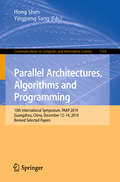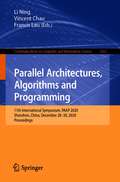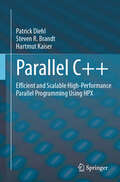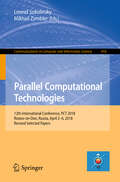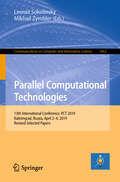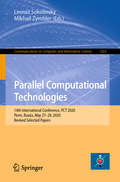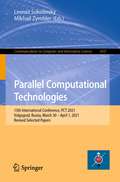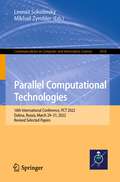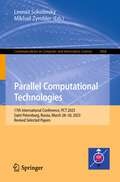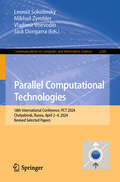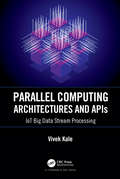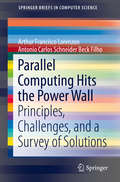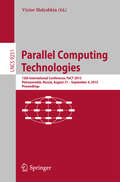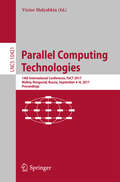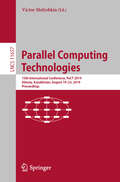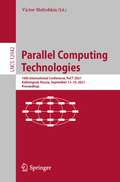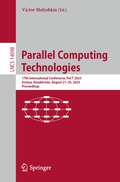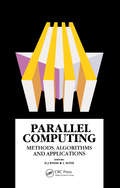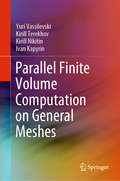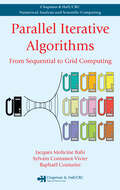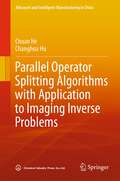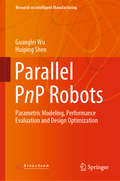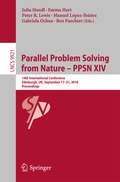- Table View
- List View
Parallel Architectures, Algorithms and Programming: 10th International Symposium, PAAP 2019, Guangzhou, China, December 12–14, 2019, Revised Selected Papers (Communications in Computer and Information Science #1163)
by Hong Shen Yingpeng SangThis book constitutes the refereed proceedings of the 10th International Symposium on Parallel Architectures, Algorithms and Programming, PAAP 2019, held in Guangzhou, China, in December 2019.The 39 revised full papers and 8 revised short papers presented were carefully reviewed and selected from 121 submissions. The papers deal with research results and development activities in all aspects of parallel architectures, algorithms and programming techniques.
Parallel Architectures, Algorithms and Programming: 11th International Symposium, PAAP 2020, Shenzhen, China, December 28–30, 2020, Proceedings (Communications in Computer and Information Science #1362)
by Francis Lau Li Ning Vincent ChauThis book constitutes the refereed proceedings of the 11th International Symposium on Parallel Architectures, Algorithms and Programming, PAAP 2020, held in Shenzhen, China, in December 2020.The 37 revised full papers presented were carefully reviewed and selected from 75 submissions. The papers deal with research results and development activities in all aspects of parallel architectures, algorithms and programming techniques.
Parallel C++: Efficient and Scalable High-Performance Parallel Programming Using HPX
by Patrick Diehl Hartmut Kaiser Steven R. BrandtThis textbook focuses on practical parallel C++ programming at the graduate student level. In particular, it shows the APIs and related language features in the C++ 17 and C++ 20 standards, covering both single node and distributed systems. It shows that with the parallel features in the C++ 17 and C++ 20 standards, learning meta-languages like OpenMP is no longer necessary. Using the C++ standard library for parallelism and concurrency (HPX), the same language features can be extended to distributed codes, providing a higher-level C++ interface to distributed programming than the Message Passing Interface (MPI). The book starts with the single-threaded implementation of the fractal sets, e.g. Julia set, and Mandelbrot set, using the C++ Standard Library (SL)’s container and algorithms. This code base is used for parallel implementation using low-level threads, asynchronous programming, parallel algorithms, and coroutines. The asynchronous programming examples are then extended to distributed programming using the C++ standard library for parallelism and concurrency (HPX). Octo-Tiger, an astrophysics code for stellar merger, is used as a showcase for a portable, efficient, and scalable high-performance application using HPX. The book’s core audience is advanced undergraduate and graduate students who want to learn the basics of parallel and distributed C++ programming but are not computer science majors. Basic C++ knowledge, like functions, classes, loops, and conditional statements, is assumed as a requirement, while C++ advanced topics, like generic programming, lambda functions, smart pointers, and move semantics, are briefly summarized in the appendix.
Parallel Computational Technologies: 11th International Conference, Pct 2017, Kazan, Russia, April 3-7, 2017, Revised Selected Papers (Communications In Computer And Information Science #753)
by Leonid Sokolinsky Mikhail ZymblerThis book constitutes the refereed proceedings of the 12th International Conference on Parallel Computational Technologies, PCT 2018, held in Rostov-on-Don, Russia, in April 2018.The 24 revised full papers presented were carefully reviewed and selected from 167 submissions. The papers are organized in topical sections on high performance architectures, tools and technologies; parallel numerical algorithms; supercomputer simulation.
Parallel Computational Technologies: 13th International Conference, PCT 2019, Kaliningrad, Russia, April 2–4, 2019, Revised Selected Papers (Communications in Computer and Information Science #1063)
by Leonid Sokolinsky Mikhail ZymblerThis book constitutes the refereed proceedings of the 13th International Conference on Parallel Computational Technologies, PCT 2019, held in Kaliningrad, Russia, in April 2019.The 24 revised full papers presented were carefully reviewed and selected from 96 submissions. The papers are organized in topical sections on high performance architectures, tools and technologies; parallel numerical algorithms; supercomputer simulation.
Parallel Computational Technologies: 14th International Conference, PCT 2020, Perm, Russia, May 27–29, 2020, Revised Selected Papers (Communications in Computer and Information Science #1263)
by Leonid Sokolinsky Mikhail ZymblerThis book constitutes refereed proceedings of the 14th International Conference on Parallel Computational Technologies, PCT 2020, held in May 2020. Due to the COVID-19 pandemic the conference was held online.The 22 revised full papers and 2 short papers presented were carefully reviewed and selected from 124 submissions. The papers are organized in topical sections on high performance architectures, tools and technologies; parallel numerical algorithms; supercomputer simulation.
Parallel Computational Technologies: 15th International Conference, PCT 2021, Volgograd, Russia, March 30 – April 1, 2021, Revised Selected Papers (Communications in Computer and Information Science #1437)
by Leonid Sokolinsky Mikhail ZymblerThis book constitutes refereed proceedings of the 15th International Conference on Parallel Computational Technologies, PCT 2021, held in March-April 2021. Due to the COVID-19 pandemic the conference was held online. The 22 revised full papers presented were carefully reviewed and selected from 89 submissions. The papers are organized in topical sections on high performance architectures, tools and technologies; parallel numerical algorithms; supercomputer simulation.
Parallel Computational Technologies: 16th International Conference, PCT 2022, Dubna, Russia, March 29–31, 2022, Revised Selected Papers (Communications in Computer and Information Science #1618)
by Leonid Sokolinsky Mikhail ZymblerThis book constitutes the refereed proceedings of the 16th International Conference on Parallel Computational Technologies, PCT 2022, held in Dubna, Russia, during March 29–31, 2022.The 22 full papers included in this book were carefully reviewed and selected from 60 submissions. They were organized in topical sections as follows: high performance architectures, tools and technologies; parallel numerical algorithms; supercomputer simulation.
Parallel Computational Technologies: 17th International Conference, PCT 2023, Saint Petersburg, Russia, March 28–30, 2023, Revised Selected Papers (Communications in Computer and Information Science #1868)
by Leonid Sokolinsky Mikhail ZymblerThis book constitutes the refereed post proceedings of the 17th International Conference on Parallel Computational Technologies, PCT 2023, held in Saint Petersburg, Russia, during March 28–30, 2023.The 25 full papers included in this book were carefully reviewed and selected from 71 submissions. They were organized in topical sections as follows: "High Performance Architectures, Tools and Technologies", "Parallel Numerical Algorithms", and "Supercomputer Simulation".
Parallel Computational Technologies: 18th International Conference, PCT 2024, Chelyabinsk, Russia, April 2–4, 2024, Revised Selected Papers (Communications in Computer and Information Science #2241)
by Jack Dongarra Vladimir Voevodin Leonid Sokolinsky Mikhail ZymblerThis book constitutes the refereed post proceedings of the 18th International Conference on Parallel Computational Technologies, PCT 2024, held in Chelyabinsk, Russia, in April 2024. The 22 full papers included in this book were carefully reviewed and selected from 62 submissions. These papers have been organized under the following topical sections: High Performance Architectures, Tools and Technologies; Parallel Numerical Algorithms and Supercomputer Simulation.
Parallel Computer Organization and Design
by Michel Dubois Murali Annavaram Per StenströmTeaching fundamental design concepts and the challenges of emerging technology, this textbook prepares students for a career designing the computer systems of the future. In-depth coverage of complexity, power, reliability and performance, coupled with treatment of parallelism at all levels, including ILP and TLP, provides the state-of-the-art training that students need. The whole gamut of parallel architecture design options is explained, from core microarchitecture to chip multiprocessors to large-scale multiprocessor systems. All the chapters are self-contained, yet concise enough that the material can be taught in a single semester, making it perfect for use in senior undergraduate and graduate computer architecture courses. The book is also teeming with practical examples to aid the learning process, showing concrete applications of definitions. With simple models and codes used throughout, all material is made open to a broad range of computer engineering/science students with only a basic knowledge of hardware and software.
Parallel Computing Architectures and APIs: IoT Big Data Stream Processing
by Vivek KaleParallel Computing Architectures and APIs: IoT Big Data Stream Processing commences from the point high-performance uniprocessors were becoming increasingly complex, expensive, and power-hungry. A basic trade-off exists between the use of one or a small number of such complex processors, at one extreme, and a moderate to very large number of simpler processors, at the other. When combined with a high-bandwidth, interprocessor communication facility leads to significant simplification of the design process. However, two major roadblocks prevent the widespread adoption of such moderately to massively parallel architectures: the interprocessor communication bottleneck, and the difficulty and high cost of algorithm/software development. One of the most important reasons for studying parallel computing architectures is to learn how to extract the best performance from parallel systems. Specifically, you must understand its architectures so that you will be able to exploit those architectures during programming via the standardized APIs. This book would be useful for analysts, designers and developers of high-throughput computing systems essential for big data stream processing emanating from IoT-driven cyber-physical systems (CPS). This pragmatic book: Devolves uniprocessors in terms of a ladder of abstractions to ascertain (say) performance characteristics at a particular level of abstraction Explains limitations of uniprocessor high performance because of Moore’s Law Introduces basics of processors, networks and distributed systems Explains characteristics of parallel systems, parallel computing models and parallel algorithms Explains the three primary categorical representatives of parallel computing architectures, namely, shared memory, message passing and stream processing Introduces the three primary categorical representatives of parallel programming APIs, namely, OpenMP, MPI and CUDA Provides an overview of Internet of Things (IoT), wireless sensor networks (WSN), sensor data processing, Big Data and stream processing Provides introduction to 5G communications, Edge and Fog computing Parallel Computing Architectures and APIs: IoT Big Data Stream Processing discusses stream processing that enables the gathering, processing and analysis of high-volume, heterogeneous, continuous Internet of Things (IoT) big data streams, to extract insights and actionable results in real time. Application domains requiring data stream management include military, homeland security, sensor networks, financial applications, network management, web site performance tracking, real-time credit card fraud detection, etc.
Parallel Computing Hits the Power Wall: Principles, Challenges, and a Survey of Solutions (SpringerBriefs in Computer Science)
by Arthur Francisco Lorenzon Antonio Carlos Beck FilhoThis book describes several approaches to adaptability that are applied for the optimization of parallel applications, such as thread-level parallelism exploitation and dynamic voltage and frequency scaling on multicore systems.This book explains how software developers can apply a novel technique to adapt the number of threads at runtime without any modification in the source code nor recompilation.This book is useful for software developers in general since it offers realistic examples throughout to demonstrate various techniques presented.
Parallel Computing Technologies
by Victor MalyshkinThis book constitutes the proceedings of the 13th International Conference on Parallel Computing Technologies, PaCT 2015, held in Petrozavodsk, Russia, during August / September 2015. The 37 full papers and 14 short papers presented were carefully reviewed and selected from 87 submissions. The papers are organized in topical sections on parallel models, algorithms and programming methods; unconventional computing; cellular automata; distributed computing; special processors programming techniques; applications.
Parallel Computing Technologies
by Victor MalyshkinThe PaCT-2001 (Parallel Computing Technologies) conference was a four-day conference held in Akademgorodok (Novosibirsk), September 3-7, 2001. This was the sixth international conference in the PaCT series, organized in Russia every odd year. The ?rst conference, PaCT-91, was held in Novosibirsk (Academgorodok), September 7-11, 1991. The next PaCT conferences were held in Obninsk (near Moscow), August 30 - September 4, 1993; in St. Petersburg, September 12-15, 1995; in Yaroslavl September 9-12, 1997; and in Pushkin (near St. Petersburg) from September 6-10, 1999. The PaCT proceedings are published by Springer- Verlag in the LNCS series. PaCT-2001 was jointly organized by the Institute of Computational Mat- maticsandMathematicalGeophysicsoftheRussianAcademyofSciences(No- sibirsk), the State University, and the State Technical University of Novosibirsk. The purpose of the conference was to bring together scientists working with theory, architecture, software, hardware, and solution of large-scale problems in order to provide integrated discussions on parallel computing technologies. The conference attracted about 100 participants from around the world. - thors from 17 countries submitted 81 papers. Of those submitted, 36 papers were selected for the conference as regular ones; there were also 4 invited - pers. In addition there were a number of posters presented. All the papers were internationally reviewed by at least three referees. As usual a demo session was organized for the participants.
Parallel Computing Technologies: 15th International Conference, PaCT 2019, Almaty, Kazakhstan, August 19–23, 2019, Proceedings (Lecture Notes in Computer Science #11657)
by Victor MalyshkinThis book constitutes the proceedings of the 15th International Conference on Parallel Computing Technologies, PaCT 2019, held in Almaty, Kazakhstan, in August 2019. The 24 full papers and 10 short papers presented were carefully reviewed and selected from 72 submissions. The papers are organized in topical sections on Programming Languages and Execution Environments; Methods and Tools for Parallel Solution of Large-Scale Problems; Data Processing; Cellular Automata; and Distributed Algorithms.
Parallel Computing Technologies: 16th International Conference, PaCT 2021, Kaliningrad, Russia, September 13–18, 2021, Proceedings (Lecture Notes in Computer Science #12942)
by Victor MalyshkinThis book constitutes the proceedings of the 16th International Conference on Parallel Computing Technologies, PaCT 2021, which was held during September 13-18, 2021. The conference was planned to take place in Kaliningrad, Russia, but changed to an online event due to the COVID-19 pandemic. The 24 full and 12 short papers included in this book were carefully reviewed and selected from 62 submissions. They were organized in topical sections as follows: parallel programming methods and tools; applications; memory-efficient data structures; experimental studies; job management; essential algorithms; computing services; and cellular automata.
Parallel Computing Technologies: 17th International Conference, PaCT 2023, Astana, Kazakhstan, August 21–25, 2023, Proceedings (Lecture Notes in Computer Science #14098)
by Victor MalyshkinThis book constitutes the refereed proceedings of the 17th International Conference on Parallel Computing Technologies, PaCT 2023, held in Astana, Kazakhstan, during August 21-25, 2023. The 15 full papers included in this book were carefully reviewed and selected from 23 submissions. They were organized in topical sections as follows: automatic programming and program tuning; frameworks and services; algorithms; and distributed systems management.
Parallel Computing: Methods, Algorithms and Applications
by David J Evans; C SuttiParallel Computing: Methods, Algorithms and Applications presents a collection of original papers presented at the international meeting on parallel processing, methods, algorithms, and applications at Verona, Italy in September 1989.
Parallel Finite Volume Computation on General Meshes
by Yuri Vassilevski Kirill Terekhov Kirill Nikitin Ivan KapyrinThis book presents a systematic methodology for the development of parallel multi-physics models and its implementation in geophysical and biomedical applications. The methodology includes conservative discretization methods for partial differential equations on general meshes, as well as data structures and algorithms for organizing parallel simulations on general meshes. The structures and algorithms form the core of the INMOST (Integrated Numerical Modelling Object-oriented Supercomputing Technologies) platform for the development of parallel models on general meshes. The authors consider applications for addressing specific geophysical and biomedical challenges, including radioactive contaminant propagation with subsurface waters, reservoir simulation, and clot formation in blood flows. The book gathers all the components of this methodology, from algorithms and numerical methods to the open-source software, as well as examples of practical applications, in a single source, making it a valuable asset for applied mathematicians, computer scientists, and engineers alike.
Parallel Iterative Algorithms: From Sequential to Grid Computing
by Jacques Mohcine Bahi Sylvain Contassot-Vivier Raphael CouturierFocusing on grid computing and asynchronism, Parallel Iterative Algorithms explores the theoretical and practical aspects of parallel numerical algorithms. Each chapter contains a theoretical discussion of the topic, an algorithmic section that fully details implementation examples and specific algorithms, and an evaluation of the advantages and dr
Parallel Operator Splitting Algorithms with Application to Imaging Inverse Problems (Advanced and Intelligent Manufacturing in China)
by Chuan He Changhua HuImage denoising, image deblurring, image inpainting, super-resolution, and compressed sensing reconstruction have important application value in engineering practice, and they are also the hot frontiers in the field of image processing. This book focuses on the numerical analysis of ill condition of imaging inverse problems and the methods of solving imaging inverse problems based on operator splitting. Both algorithmic theory and numerical experiments have been addressed. The book is divided into six chapters, including preparatory knowledge, ill-condition numerical analysis and regularization method of imaging inverse problems, adaptive regularization parameter estimation, and parallel solution methods of imaging inverse problem based on operator splitting. Although the research methods in this book take image denoising, deblurring, inpainting, and compressed sensing reconstruction as examples, they can also be extended to image processing problems such as image segmentation, hyperspectral decomposition, and image compression. This book can benefit teachers and graduate students in colleges and universities, or be used as a reference for self-study or further study of image processing technology engineers.
Parallel PnP Robots: Parametric Modeling, Performance Evaluation and Design Optimization (Research on Intelligent Manufacturing)
by Huiping Shen Guanglei WuThis book discusses the parametric modeling, performance evaluation, design optimization and comparative study of the high-speed, parallel pick-and-place robots. It collects the modeling methodology, evaluation criteria and design guidelines for parallel PnP robots to provide a systematic analysis method for robotic developers. Furthermore, it gathers the research results previously scattered in many prestigious international journals and conference proceedings and methodically edits them and presents them in a unified form. The book is of interest to researchers, R&D engineers and graduate students in industrial parallel robotics who wish to learn the core principles, methods, algorithms, and applications.
Parallel Population and Parallel Human: A Cyber-Physical Social Approach (IEEE Press Series on Systems Science and Engineering)
by Fei-Yue Wang Peijun YeParallel Population and Parallel Human Proposes a new paradigm to investigate an individual’s cognitive deliberation in dynamic human-machine interactions Today, intelligent machines enable people to interact remotely with friends, family, romantic partners, colleagues, competitors, organizations, and others. Virtual reality (VR), augmented reality (AR), artificial intelligence (AI), mobile social media, and other technologies have been driving these interactions to an unprecedented level. As the complexity in system control and management with human participants increases, engineers are facing challenges that arise from the uncertainty of operators or users. Parallel Population and Parallel Human: A Cyber-Physical Social Approach presents systemic solutions for modeling, analysis, computation, and management of individuals’ cognition and decision-making in human-participated systems, such as the MetaVerse. With a virtual-real behavioral approach that seeks to actively prescribe user behavior through cognitive and dynamic learning, the authors present a parallel population/human model for optimal prescriptive control and management of complex systems that leverages recent advances in artificial intelligence. Throughout the book, the authors address basic theory and methodology for modeling, describe various implementation techniques, highlight potential acceleration technologies, discuss application cases from different fields, and more. In addition, the text: Considers how an individual’s behavior is formed and how to prescribe their behavioral modes Describes agent-based computation for complex social systems based on a synthetic population from realistic individual groups Proposes a universal algorithm applicable to a wide range of social organization types Extends traditional cognitive modeling by utilizing a dynamic approach to investigate cognitive deliberation in highly time-variant tasks Presents a new method that can be used for both large-scale social systems and real-time human-machine interactions without extensive experiments for modeling Parallel Population and Parallel Human: A Cyber-Physical Social Approach is a must-read for researchers, engineers, scientists, professionals, and graduate students who work on systems engineering, human-machine interaction, cognitive computing, and artificial intelligence.
Parallel Problem Solving from Nature – PPSN XIV
by Emma Hart Gabriela Ochoa Manuel López-Ibáñez Julia Handl Peter R. Lewis Ben PaechterThis book constitutes the refereed proceedings of the 14th International Conference on Parallel Problem Solving from Nature, PPSN 2016, held in Edinburgh, UK, in September 2016. The total of 93 revised full papers were carefully reviewed and selected from 224 submissions. The meeting began with four workshops which offered an ideal opportunity to explore specific topics in intelligent transportation Workshop, landscape-aware heuristic search, natural computing in scheduling and timetabling, and advances in multi-modal optimization. PPSN XIV also included sixteen free tutorials to give us all the opportunity to learn about new aspects: gray box optimization in theory; theory of evolutionary computation; graph-based and cartesian genetic programming; theory of parallel evolutionary algorithms; promoting diversity in evolutionary optimization: why and how; evolutionary multi-objective optimization; intelligent systems for smart cities; advances on multi-modal optimization; evolutionary computation in cryptography; evolutionary robotics - a practical guide to experiment with real hardware; evolutionary algorithms and hyper-heuristics; a bridge between optimization over manifolds and evolutionary computation; implementing evolutionary algorithms in the cloud; the attainment function approach to performance evaluation in EMO; runtime analysis of evolutionary algorithms: basic introduction; meta-model assisted (evolutionary) optimization. The papers are organized in topical sections on adaption, self-adaption and parameter tuning; differential evolution and swarm intelligence; dynamic, uncertain and constrained environments; genetic programming; multi-objective, many-objective and multi-level optimization; parallel algorithms and hardware issues; real-word applications and modeling; theory; diversity and landscape analysis.
